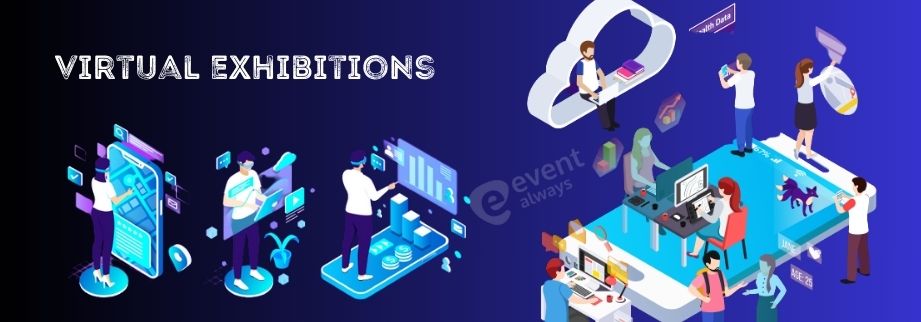In today’s fast-paced and interconnected world, technology has revolutionized the way we experience and engage with various aspects of life, including the world of art, culture, and business. One significant development in this digital age is the rise of virtual exhibition. These online showcases have gained immense popularity, providing a virtual event platform for artists, businesses, and organizations to reach a global audience and accomplish a multitude of objectives. In this article, we will delve into the main purposes of virtual exhibition and explore how they have transformed the traditional exhibition landscape.
Exploring the Concept of Virtual Exhibition
Virtual exhibitions, often referred to as online exhibitions or digital showcases, are curated presentations of art, products, services, or information accessible through the internet. They simulate the experience of visiting a physical exhibition or showroom, allowing visitors to browse, interact, and engage with the content from the comfort of their own devices.
Expanding Audience Reach
One of the primary purposes of virtual exhibition is to break geographical boundaries and reach a global audience. Unlike physical exhibitions that are limited by location and accessibility, virtual exhibition can be accessed by anyone with an internet connection, making them a powerful tool for artists, businesses, and institutions looking to expand their reach.
Showcasing Diverse Content
Virtual exhibition provide a versatile platform for showcasing diverse content. From art galleries displaying paintings and sculptures to businesses promoting their products and services, these digital showcases can accommodate a wide range of content types. This diversity allows for a broader audience appeal.
Cost-Effective Exhibition Solution
Hosting a physical exhibition can be financially burdensome, involving expenses for venue rental, logistics, and promotional materials. Virtual exhibitions offer a cost-effective alternative, eliminating many of these overhead costs. This affordability makes it possible for emerging artists and small businesses to participate in exhibitions they might otherwise be unable to afford.
Enhanced Interactivity and Engagement
Unlike static displays in traditional events, online exhibitions often incorporate interactive elements. Visitors can zoom in on artwork, watch videos, listen to audio guides, and even engage in live chats with exhibitors. This enhanced interactivity fosters deeper engagement and a more immersive experience.
Preserving Cultural Heritage
Museums and cultural institutions utilize virtual exhibitions to preserve and share their collections with a wider audience. This digital approach helps protect valuable artifacts and artworks while making them accessible for educational and research purposes.
Bridging the Gap Between Art and Technology
Virtual exhibition are at the intersection of art and technology. They allow artists to experiment with digital mediums, pushing the boundaries of creativity. Additionally, they introduce new audiences to art forms that may not be accessible in their physical locations.
Marketing and Brand Exposure
Boots your business with virtual exhibitions , as part of marketing. They can showcase their products, demonstrate their expertise, and connect with potential customers. This not only enhances brand exposure but also generates leads and sales.
Environmental Sustainability
In an era where sustainability is a growing concern, online exhibitions contribute to environmental conservation. By reducing the need for physical transportation and minimizing waste, these exhibitions have a smaller carbon footprint.
Inclusivity and Accessibility
Online exhibitions are inclusive by design, offering accessibility features for people with disabilities. This commitment to inclusivity ensures that everyone, regardless of their physical or cognitive abilities, can enjoy and engage with the content.
Analytics and Data Insights
One significant advantage of virtual exhibition is the ability to collect valuable data insights. Organizers can track visitor behavior, preferences, and interactions, enabling them to make data-driven decisions for future exhibitions.
Collaboration and Networking
Virtual exhibitions facilitate collaboration and networking among artists, businesses, and attendees. They provide a platform for like-minded individuals to connect, share ideas, and foster partnerships.
Adaptation to Changing Times
Especially in times of crisis, such as the COVID-19 pandemic, virtual exhibition have proven invaluable. They allow exhibitions to continue without the need for physical gatherings, ensuring the safety of participants and visitors.
Education and Learning Opportunities
Virtual exhibitions are not only for entertainment and marketing; they also serve as educational tools. Schools, universities, and educational institutions use them to create immersive learning experiences for students.
Conclusion
In conclusion, virtual exhibition have emerged as a dynamic and multifaceted tool that serves various purposes in our digital age. They have revolutionized the way we access and engage with art, culture, and commerce. From expanding audience reach to preserving cultural heritage and fostering inclusivity, Online exhibitions have proven to be a transformative force.

